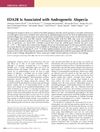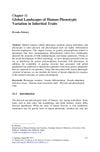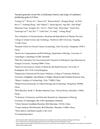TLDR The research concluded that selection significantly shaped the genetic variation of the X chromosome, with certain regions affected by past selective events.
The study analyzed 16,297 X-linked SNPs from the CEPH human genome diversity project and found greater differentiation on the X chromosome between human populations compared to autosomes, suggesting the influence of selective sweeps. Two regions on the X chromosome were identified as outliers, indicating past selection influences. The study also noted that demographic events like bottlenecks or migration patterns could have influenced genetic variation. Using 3 million SNPs from HapMap samples, the research found evidence of selection on the X chromosome, particularly in genes associated with diseases and traits like androgenic alopecia. The study concluded that selection has played a significant role in shaping X chromosome genetic variation and that geographically diverse samples are crucial for identifying genomic targets of selection.
 42 citations
,
April 2009 in “Human Genetics”
42 citations
,
April 2009 in “Human Genetics” A specific genetic mutation may increase male pattern baldness risk, especially in Europeans.
 82 citations
,
April 2008 in “Journal of Investigative Dermatology”
82 citations
,
April 2008 in “Journal of Investigative Dermatology” EDA2R gene linked to hair loss.
 195 citations
,
June 2005 in “American Journal of Human Genetics”
195 citations
,
June 2005 in “American Journal of Human Genetics” Genetic variation in the androgen receptor gene mainly causes early-onset hair loss, with maternal inheritance playing a key role.
 4 citations
,
December 2012 in “Human Biology”
4 citations
,
December 2012 in “Human Biology” The most different genetic segment between Africans and East Asians is the EDA2R/AR region, with two main types influenced by population changes and natural selection, and linked to baldness.
 1 citations
,
January 2017 in “Evolutionary studies”
1 citations
,
January 2017 in “Evolutionary studies” Different human traits like skin color and hair type vary between populations due to genetic adaptations to the environment.
 27 citations
,
April 2020 in “Molecular Biology and Evolution”
27 citations
,
April 2020 in “Molecular Biology and Evolution” Ancient Chinese goats evolved cashmere-producing traits due to selective breeding, particularly in genes affecting hair growth.
 August 2025 in “Aesthetic Plastic Surgery”
August 2025 in “Aesthetic Plastic Surgery” Collaboration and innovation are key to developing effective, safe hair loss treatments.
2 citations
,
April 2022 in “Genes” The study found that the hair loss condition in Cesky Fousek dogs is influenced by multiple genes affecting skin and muscle structure, fat metabolism, and immunity.







